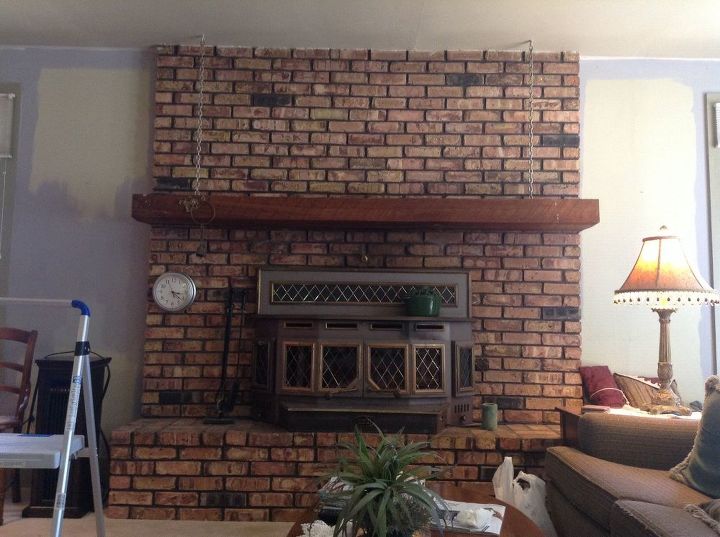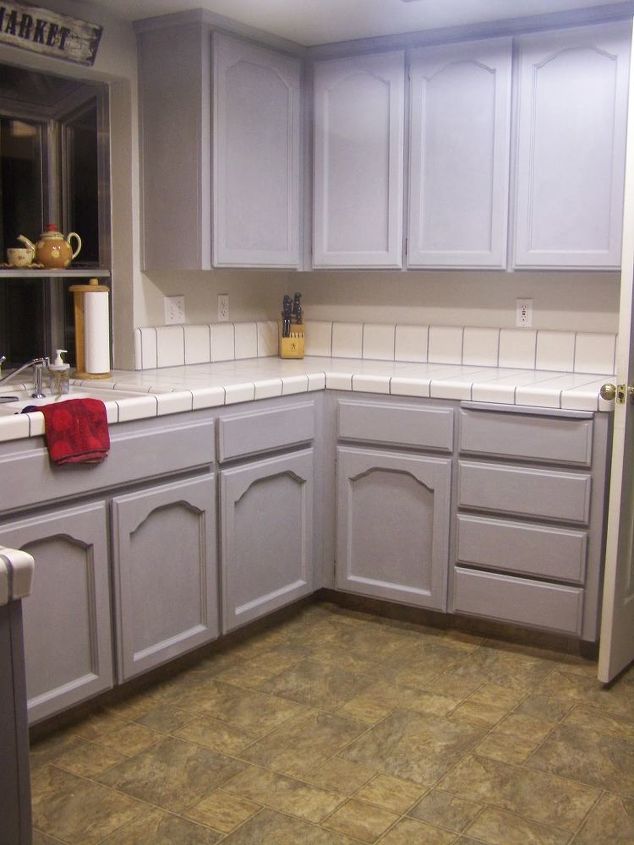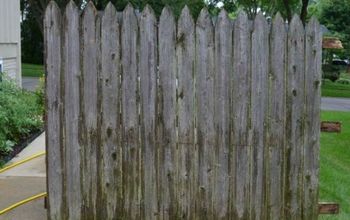General finishes-gel stain grey, and another gel stain question

1-a darker (walnut) finished piece (I've attached a photo of the piece I'm considering)
I'm also wondering if anyone has tried the gel stain over painted pieces!
Thanks!
-
I've never used gel stain but I personally really like Polyshades stain - you don't have to go back over it with polyurethane, etc. It also applies really easily. It works best on unfinished wood, however, I've used it over painted wood to distress it and it worked fine. Good luck!
 Gathered In The Kitchen
on Jan 22, 2016
Helpful Reply
Gathered In The Kitchen
on Jan 22, 2016
Helpful Reply -
-
I too was wondering about the gray gel stain. I have used the GF Gel stain,but had to sand down finish that was on dresser before I used it. It was prairie wheat. I sampled it over a painted piece(dark gray) and didn't look so well to me. I know you can put different stains on top of each other.
Ruth on Jan 22, 2016
Helpful Reply -
-
I have light cabinets wondered if you can gel stain over their poly finish
 Darlene dynka
on Jan 23, 2016
Helpful Reply
Darlene dynka
on Jan 23, 2016
Helpful Reply -
-
This is from Minwax Gel Stain: WOOD PROJECTS: SURFACE PREPARATION: Surface must be dry, clean, and free of dirt, grease, glue, and existing coatings before staining. Sand the wood in the direction of the grain using a fine-grade sandpaper (#220) until smooth. Remove all sanding dust. To help ensure uniform acceptance of stain color and beautiful results, pretreat the wood with Minwax® Pre-Stain Wood Conditioner following label directions. PRODUCT PREPARATION AND COLOR TESTING: Stir Minwax® Gel Stain until creamy before and occasionally during use. Do not thin. Always test stain on a scrap piece or hidden area of the wood to verify desired color. STAIN APPLICATION: Apply a liberal amount of stain evenly with a brush or clean cloth. Wait 3 minutes and remove the excess stain with a clean cloth, wiping in the direction of the grain. Allow to dry 8-10 hours. To darken the color, apply additional coats of Minwax® Gel Stain repeating directions for application of first coat. Allow the stain to dry 8 to 10 hours between coats. Do not sand between coats. CLEAR FINISH APPLICATION: After 24 hours (dry time may be extended due to heavy application, low temperatures or high humidity), complete your project by applying a clear protective finish. Recommended finishes include Minwax® Fast-Drying Polyurethane or Water Based Oil Modified Polyurethane or Helmsman® Spar Urethane for exterior use. FIBERGLASS DOOR PROJECTS: For ease of staining and finishing, it is recommended that you finish the door before installation. PREPARATION: Make sure the door surface is free of all dirt and foreign matter. Stir Minwax® Gel Stain until creamy before use and occasionally during use. STAIN APPLICATION: Using a high quality natural bristle brush, spread a thin, even coat over the entire surface, starting with the raised panel sections. Always make final brush strokes in the direction of the embossed grain. Areas of heavier coats should be evened out before moving to a new section. Allow stain to dry approximately 6 to 8 hours. To darken the color, apply additional coats by following the instructions above. Let the stain dry 6 to 8 hours between coats. CLEAR FINISH APPLICATION: Be sure to apply a clear protective finish such as Minwax® Fast-Drying Polyurethane for interior use or Minwax® Helmsman® Spar Urethane for exterior applications. Before applying a clear finish, test the stain for dryness by wiping a small hidden area with a rag moistened with mineral spirits. If the last coat of stain can be removed with mineral spirits, do not apply a clear protective finish. Wait until the stain is completely dry. Allow the finish to dry at least 6 hours before installing or closing the door to avoid sticking. For exterior applications, apply a coat of clear protective finish every 12-24 months to keep the door looking beautiful. METAL DOOR PROJECTS: SURFACE PREPARATION: You will need: a graining tool, clean, dry, lint-free cloths, and clean, dry synthetic brushes. (Practice with the graining tool on a piece of scrap following the instructions in Step 3 until you feel comfortable using it.) Most metal doors come already primed, but usually not in the color you should be starting with. Select an oil-based base coat tinted to match the light tone in the wood you're trying to create. Apply a thin layer of the base coat paint to the entire door and allow it to dry thoroughly. Then, mask all areas, such as glass, that you do not wish to stain and remove all hardware and doorknobs. Clean the surface with a cloth dampened with mineral spirits to remove all dust, grease and dirt. STAIN APPLICATION: Plan to work on the door in separate vertical and horizontal sections. Mask off the horizontal sections as you work on the vertical sections. The vertical sections need to be masked off when working on the horizontal sections. Each section must be completely dry before either removing or applying masking tape. Select a Minwax® Gel Stain color that corresponds to the darkest color of the wood grain you are trying to create. Test stain on hidden area to verify desired color. Apply a thin, even coat of Gel Stain to a section using a natural bristle brush or a soft, lint-free cloth. Apply in the direction of the grain you intend to create. GRAINING: While the Gel Stain is wet, use a graining tool to create a wood grain pattern. Apply downward pressure while moving the graining tool across the section at a constant speed. Use a long, steady, non-stop stroke -- rocking the tool one rotation as you move from beginning to end. Keep the graining tool clean by wiping it often with a rag or paper towel between strokes. Repeat the above steps section by section. Not satisfied? Either wipe the surface clean or re-brush the area and start over again. Wet or tacky Gel Stain can be removed easily with a rag moistened with mineral spirits. To complete the graining process, wait until the first coat of Minwax® Gel Stain is completely dry (24-48 hours), then apply a second coat of Gel Stain with a natural bristle brush in the direction of the grain pattern created. Work section by section as you did before. There is no need to mask off any sections. While the Gel Stain is wet, you’ll want to use a clean, dry synthetic brush to remove the excess stain and create a uniform look. Use long brush strokes in the direction of the grain and remove the Gel Stain from the brush as it begins to accumulate with paper towels or a rag. The amount of Gel Stain left on will determine the depth of color. Helpful Hints: On metal doors, use masking tape to mask off areas where sections meet. Let the section dry to the touch before working on a section next to it. This ensures a clean, straight edge where panels meet. COVERAGE: Approximately 200 sq. ft. per quart. CLEANUP: Use mineral spirits or paint thinner. DANGER: Rags, steel wool, other waste soaked with this product, and sanding residue may spontaneously catch fire if improperly discarded. Immediately place rags, steel wool, other waste soaked with this product, and sanding residue in a sealed, water-filled, metal container. Dispose of in accordance with local fire regulations. CAUTIONS: CONTAINS ALIPHATIC HYDROCARBONS. Contents are COMBUSTIBLE. Keep away from heat and open flame. VAPOR HARMFUL. Use only with adequate ventilation. To avoid overexposure, open windows and doors or use other means to ensure fresh air entry during application and drying. If you experience eye watering, headaches, or dizziness, increase fresh air, or wear respiratory protection (NIOSH approved) or leave the area. Avoid contact with eyes and skin. Wash hands after using. Keep container closed when not in use. Do not transfer contents to other containers for storage. FIRST AID: In case of eye contact, flush thoroughly with large amounts of water for 15 minutes and get medical attention. For skin contact, wash thoroughly with soap and water. In case of respiratory difficulty, provide fresh air and call physician. If swallowed, call Poison Control Center, hospital emergency room, or physician immediately. DELAYED EFFECTS FROM LONG TERM OVEREXPOSURE. Contains solvents which can cause permanent brain and nervous system damage. Intentional misuse by deliberately concentrating and inhaling the contents can be harmful or fatal. WARNING: This product contains chemicals known to the State of California to cause cancer and birth defects or other reproductive harm. DO NOT TAKE INTERNALLY. KEEP OUT OF THE REACH OF CHILDREN. CONFORMS TO ASTM D-4236. Contact a physician for more health information.
 LD
on Jan 23, 2016
Helpful Reply
LD
on Jan 23, 2016
Helpful Reply -
-
I used GF Java gel stain over and oak kitchen island. I didn't sand down to bare wood. Just kind of scuffed it with sandpaper. This was about 3 coats. The first coat will look terrible.
 Sandi Jones
on Jan 23, 2016
Sandi Jones
on Jan 23, 2016
 Helpful Reply
Helpful Reply -
-
It looks like you like wood, but if you decided to get into colors try the Unicorn spit. I just did my first trial piece and I love it.. the smell is very nice also. make a mistake and washed off so I could start over. When done seal it. look her up there have projects on this sight.
 Kathy Bitzan
on Jan 23, 2016
Helpful Reply
Kathy Bitzan
on Jan 23, 2016
Helpful Reply -
-
TDeren I wish I knew how to add a link for you, but I don't . sorry it is a stain that can be used many ways. I don't want to down play it so best you type it in and it should come up. they have a few projects on this site. I just started using them myself.
 Kathy Bitzan
on Jan 23, 2016
Helpful Reply
Kathy Bitzan
on Jan 23, 2016
Helpful Reply -
Related Discussions
Should I paint or stain my oak kitchen cabinets?
I was wondering if you could help me with something -- I have an entirely oak kitchen. I know it's the rage now to paint or gel stain cabinets. I've been considering ... See more
How to paint a metal front door?
How do I paint my front door? It's metal.
How to paint grout?
How do I paint grout to change the color? The grout is in great shape, but the color - meh.
How to whitewash a brick fireplace?
What is the best method to whitewash bricks surrounding a fireplace?
Should I re-stain or paint my cabinets?
Edit:””” 3 years later😂 I decided to paint them white and I am so very pleased with the results!We bought a new house with these ugly cabinets. I really cann... See more
Stripping off A LOT of chalk paint
I've had my first (of many, I'm sure) disastrous DIY project. I have covered my entire kitchen cabinetry with chalk paint and I hate it. It's streaky, it's cracking, ... See more





